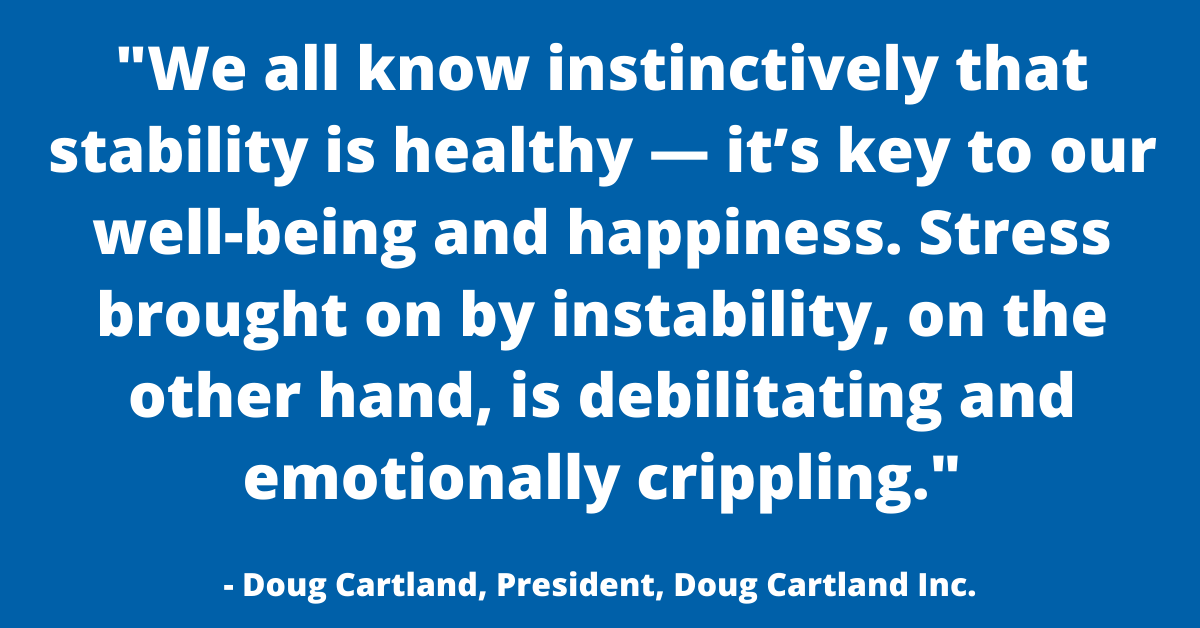 Guest editorial
Guest editorial
Doug Cartland, President, Doug Cartland Inc.
This article was published in the August 2020 edition of NTEA News.
Instability is a nightmare to the employee.
With instability comes uncertainty, and with uncertainty is stress. With undue stress is debilitating distraction and reduction in confidence, happiness and morale.
There is instability caused by shortsighted leadership, but that’s another article for another day. Then, there’s the kind that gets thrown in our faces. Enter coronavirus.
We’re living in difficult and strange times. But these are not the first.
I marvel at the 1960s, but more so, how insulated I was from the realities of the decade.
In 1963, President Kennedy was murdered. And then, so was his murderer.
During those years, the Soviet Union nuclear bomb threat was very real.
There was racial violence and unrest, especially in the South.
Malcolm X was finding a different, better voice. But, because of it, he was murdered by Nation of Islam extremists in 1965.
Dr. Martin Luther King Jr. was preaching equality across the land, leading sit-ins and protests and marches.
We were in a lost war in Vietnam in which thousands of our young people were shipped off.
People across the country were marching against the war.
The year 1968 was an exclamation mark. In April, King was murdered. Two months later, Robert Kennedy, while running for president, was murdered. Two months later, 10,000 protesters descended upon Chicago at the Democratic National Convention, and were met by riot police.
My remembrances of those events are flickering TV images of violence, funerals, shouting and tears. I would stare quizzically at the black-and-white images coming back at me, and I wondered.
And yet, I felt nary a bump.
You see, my parents had done the job of parents. They didn’t shield us from the realities. They didn’t flip off the TV. They never denied the happenings.
What they provided, though, was stability. A stable home in which our minds and emotions could cultivate. In which we were, by and large, happy kids.
We all know instinctively that stability is healthy — it’s key to our well-being and happiness. Stress brought on by instability, on the other hand, is debilitating and emotionally crippling.
In times like these, it’s easy to preach stability, but harder to create it. I get it. But leaders, it’s especially in times of turmoil that people look to you, and you earn your keep.
Stability is controlling what we can and managing what we can’t. It’s not staring down the barrel of what might happen, but focusing on what is happening. It’s feeling the storm, but not being overwhelmed by it.
Rumors are one of the real destabilizers in business, particularly in times like these. You squelch them by communicating often and thoroughly. You tell the truth about the current state to your employees, but give your honesty the context of confidence and expected ultimate success.
Stability is offering as few sudden changes as possible. It’s making sure people aren’t struck by surprises they weren’t braced for.
Stability is holding to our good habits in the midst of it all, like communication, planning, delegation, training, cooperation and organization.
Stability is not panicking and ditching objectives for the year, either. It’s keeping your people on a steady course, even if it must be adjusted as we go.
It’s being seen by your people. And in being seen, stability is conveying security and confidence by how you carry yourself.
Indeed, if you’re looking for a steady hand during the tumult, then I suggest you look down.
It’s at the end of your wrist.
Learn more about Cartland’s Aug. 25 webinar, Leading people successfully through change.